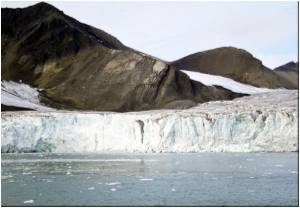Results of a research expedition in Antarctic waters say that Antarctica, the ice-covered mass of land on the earth was once a warm greenhouse or hothouse world.

Then suddenly, Antarctica's lush environment transitioned into its modern icy realm.
Newly acquired climate records tell a tale of this long-ago time. The records were recovered from Antarctica, preserved in sediment cores retrieved during the Integrated Ocean Drilling Program (IODP) Wilkes Land Glacial History Expedition from Jan. 4 - March 8, 2010.
Wilkes Land is the region of Antarctica that lies due south of Australia, and is believed to be one of the most climate-sensitive regions of the polar continent.
In only 400,000 years-a mere blink of an eye in geologic time-concentrations of atmospheric carbon dioxide there decreased. Global temperatures dropped. Ice sheets developed and Antarctica became ice-bound.
The researchers wondered how did this change happen so abruptly, and how stable can we expect ice sheets to be in the future.
Advertisement
"The new cores offer an unprecedented ability to decipher the history of glaciation in Antarctica. The climate record they preserve is immensely valuable, especially for testing how well current global climate models reproduce past history," said Jamie Allen, program director in the National Science Foundation (NSF)'s Division of Ocean Sciences.
Advertisement
"These sediments are essential to our research because they preserve the history of the Antarctic ice sheet," said Carlota Escutia of the Research Council of Spain CSIC-University of Granada, who led the expedition.
"We can read these sediments like a history book. And this book goes back 53 million years, giving us an unprecedented record of how ice sheets form and interact with changes in the climate and the ocean," said co-chief scientist Henk Brinkhuis of Utrecht University in the Netherlands.
The new core samples collected during the expedition are unique because they provide the world's first direct record of waxing and waning of ice in this region of Antarctica.
Combined, the cores tell a story of Antarctica's transition from an ice-free, warm, greenhouse world to a cold, dry, "icehouse" world.
Sediments and microfossils preserved within the cores document the onset of cooling and the development of the first Antarctic glaciers, as well as the growth and recession of Antarctica's ice sheets.
Cores from one site resemble tree rings-alternating bands of light and dark sediment preserve seasonal variability of the last deglaciation, which began some 10,000 years ago.
Understanding the behaviour of Antarctica's ice sheets plays an important role in our ability to build effective global climate models, which are used to predict future climate say scientists.
Source-ANI
RAS









